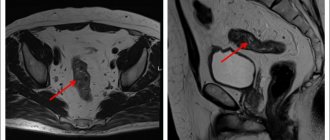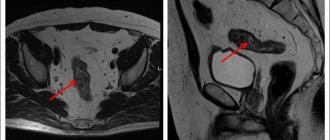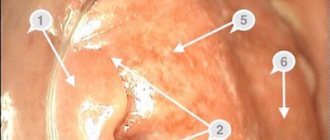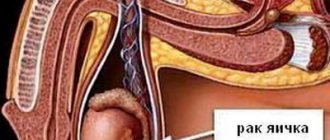- The first symptoms of cancer
- What are precancerous conditions?
- Why is it important to confirm or deny cancer symptoms as soon as possible?
- Diagnosis of cancer in Oncology
Due to the importance of early diagnosis, the question naturally arises: what are the first signs of cancer? What exactly should cause concern and become a reason for a visit to a specialist? Unfortunately, early self-diagnosis of malignant neoplasms is almost impossible. In the vast majority of cases, cancer tumors at the first, and often at the second stage of their development, do not have any significant manifestations. Of the rare exceptions, one can mention melanoma - the most common type of skin cancer. Almost always, such a tumor is located on the surface of the skin and has the appearance of a rapidly growing mole or changing its shape and color. With regular self-examinations and a certain amount of attentiveness, these changes in nevus (skin formations) can be noticed quite quickly. And contact an oncodermatologist for in-depth diagnostics. In other cases, until the tumor acquires significant size and begins to seriously disrupt the functioning of surrounding organs, it is extremely difficult to identify it. Moreover, even if a person develops any symptoms of cancer in the early stages of development, they will be very blurry, unclear and non-specific. The term "nonspecific" means that this manifestation cannot be evidence of a specific disease. For example, elevated temperature occurs not only with tumors, but also with colds, autoimmune pathologies, poisoning and hundreds of other disorders in our body. Or a symptom such as bleeding during bowel movements can serve as both an indicator of a collapsing neoplasm and a manifestation of an anal fissure.
The first symptoms of cancer in women and men
So, at an early stage, malignant tumors almost never give clinical symptoms.
But what exactly disorders appear when the tumor has already reached a significant size? First of all, we should highlight the so-called symptom complex of minor oncological signs:
- persistent, but at first glance unreasonable increase in temperature to moderate numbers (about 37.5 ºС);
- fatigue and weakness;
- periodic dizziness;
- loss of appetite;
- nausea;
- increased drowsiness;
- enlargement of various groups of lymph nodes;
- unmotivated weight loss.
These symptoms are also nonspecific and are characteristic of many pathologies.
But their appearance in combination, especially against the background of the absence of clinical signs of any other disease, should cause caution. This symptom complex occurs in 80–85% of cancer patients, and already at the second stage of tumor development. In the future, signs of cancer will be determined mainly by the location of the tumor:
- lip cancer looks like non-healing ulcerations on the mucous membranes or areas of its hardening/keratinization;
- cancer of the pharynx and larynx leads to swallowing problems and changes in voice, breathing difficulties, and bloody discharge from the nasopharynx;
- symptoms of thyroid cancer are discomfort when swallowing, a feeling of a lump in the throat and sometimes even a visually noticeable increase in the size of the gland;
- Lung cancer is characterized by the appearance of cough and sputum, which contains blood impurities;
- breast cancer is manifested by dense areas in the thickness of the tissue, asymmetry of the glands, changes in the nipple and sometimes bloody discharge;
- signs of stomach and intestinal cancer are a wide variety of digestive disorders and the passage of food through the gastrointestinal tract, nausea and vomiting;
- liver cancer very quickly manifests itself as obstructive jaundice of the skin and eye sclera;
- rectal cancer leads to pain during bowel movements, mucus or blood in the stool, as well as constipation, which alternates with diarrhea;
- bladder and prostate cancer in men is characterized by urination disorders, as well as pain in the lumbosacral region;
- In women, gynecological cancer tumors are accompanied by leucorrhoea or extramenstrual bleeding from the woman’s genital tract, pain and discomfort during sexual intercourse.
Methods of treating oncopathologies
Cancer is a serious disease, and when patients hear this diagnosis, they often immediately judge themselves. But cancer research is moving forward. Therefore, now we cannot say that this is a disease that necessarily leads to death.
There are several paths to recovery, the first of which is surgical. The tumor is removed to prevent diseased cells from continuing to grow. At the first stage of cancer development, surgical intervention can completely eliminate the further development of pathology.
Chemotherapy
– This is treatment with drugs that suppress the functioning of cancer cells. This causes them to stop dividing and the tumor stops growing.
Irradiation
is a type of treatment that uses high-energy rays that kill diseased cells. Used in conjunction with surgery and chemotherapy.
Hormonal treatment
used if the mammary glands are affected. This treatment suppresses the increase in the number of diseased cells.
Immunotherapy is also used
, during which the body’s immunity is stimulated to work. Through this treatment, the cells are destroyed by antibodies.
In addition, there is treatment with inhibitors that interact with proteins of diseased cells, causing them to stop dividing. Oncology treatment is individualized, and several methods are almost always used together.
The Clinic of Dr. Paramonov employs highly qualified oncologists and uses advanced methods and developments in the treatment of oncological pathologies. You can make an appointment with an oncologist by phone.
What are precancerous conditions?
Symptoms of cancer are direct evidence of the existence of a malignant tumor.
But such neoplasms sometimes develop not on healthy tissue, but on an already existing “substrate”. Certain disorders, which in medicine are usually called precancerous or background diseases, serve as such a “substrate”. Let us emphasize: such a pathology is not yet a cancerous tumor and it is far from a fact that it will necessarily arise in this place. However, identifying a precancerous lesion increases the likelihood of tumor development, which means the patient requires careful medical supervision. The most common precancerous conditions are:
- ulcers, cracks, erosions, as well as leukoplakia (“white spot”) on the mucous membranes of the oral cavity;
- papillomas, keratinization and benign (fibromas, adenomas, etc.) tumors in the larynx and nasopharynx;
- goiter of the thyroid gland, especially its nodular form;
- warts and nevi on the skin, areas of chronic weeping or trauma;
- diffuse and focal mastopathy of the mammary glands;
- chronic atrophic gastritis, gastric and duodenal ulcers;
- chronic ulcerative colitis, intestinal fistulas, polyps of the colon and rectum;
- chronic inflammatory lesions of the urinary system, as well as the prostate gland;
- benign tumors (adenoma) of the prostate;
- leuko- and erythroplakia of the vagina, erosions and ectropions of the cervix, any benign gynecological tumors (polyps, fibroids, fibroadenomas, etc.).
Viral cause
One popular theory is the viral nature of cancer. In 2008, one of the Nobel laureates was Harold Zurhausen , who proved that viruses can lead to the development of cancer tumors. It was he who proved that cervical cancer is caused by papillomavirus. Moreover, such a theory was previously put forward even by Soviet doctors, but they lacked the technology and diagnostic equipment that would allow them to create an evidence base.
It's scary not to know. Over six months, the number of deaths from cancer decreased by 3.9% Read more
There is also often talk about a connection between the Epstein-Barr virus and the development of cancer. It is clear that we are not talking about common respiratory viruses. Here, rather, we are talking about a number of specific pathogens. However, discoveries about viruses have led to the creation of a new prevention program in the form of vaccination.
Why is it important to confirm or deny cancer symptoms as soon as possible?
There is only one reason here - the earlier a malignant neoplasm is detected, the more chances the patient will have for a complete cure. More than 90% of cancers diagnosed at the first stage of development end in recovery. Therefore, if you discover suspicious symptoms, do not hesitate to visit a specialist and undergo an initial examination. It is better to make sure once again that your fears were unfounded than to miss the onset of pathology - the price of such delay can be very high.
Cost of diagnostic procedures
| Oncological Check-Up basic | 35500 rub. |
| Comprehensive Colono-Gastro program | 44,000 rub. |
| Comprehensive diagnostic program EndoUS | 64500 rub. |
| Appointment with a mammologist | 5100 rub. |
| Appointment with an oncologist | 5100 rub. |
| Digital videodermatoscopy Photofinder | 12100 rub. |
Book a consultation 24 hours a day
+7+7+78
Diagnosis of cancer in Oncology
The most reliable way to detect the first signs of cancer is through periodic preventive examinations.
They need to be completed annually for people at risk of developing malignant neoplasms. Risk factors include:
- presence of relatives with confirmed cancer pathologies;
- identification of specific genetic mutations in humans;
- occupational hazards in the form of constant contact with carcinogenic chemical compounds, ultraviolet radiation or ionizing radiation;
- bad ecology.
In addition, the most important risk factor for the appearance of neoplasms is age.
Cancer is a mutation of cells. And damage to genetic material constantly occurs during cell division and accumulates during a person’s life. This explains the fact that tumor diseases are much more common in older people. According to WHO recommendations, all men over 45 years of age should undergo prostate screening examinations every year. And all women over 40 years of age are prescribed preventive mammography or ultrasound of the mammary glands every year. From about this age, each person also needs annual examinations by a proctologist and an X-ray examination of the lungs.
You can undergo all these examinations comprehensively at the Oncology Center.
In addition to screening programs, we also conduct general oncological diagnostics at the request of the patient. Such an examination may include:
1. Laboratory tests
- Determination of the concentration of cancer markers in the blood. Their increased number does not necessarily mean the presence of a malignant tumor, but serves as an additional diagnostic criterion.
- Molecular genetic analysis. With its help, you can find specific mutations in a patient that increase the risk of developing certain cancers (for example, the mutant BRCA gene associated with breast and ovarian cancer). Knowing about this feature of the body, a person will monitor his condition more closely, which significantly increases the chances of detecting cancer symptoms at an early stage and consulting a doctor in time.
- Comprehensive DNA diagnostics. This is a genetic examination of close relatives, carried out if one of them has a cancer-associated mutation. This study allows us to determine the risk of cancer personally for each family member.
2. Ultrasound examinations
This is another method to detect signs of cancer. Ultrasound has a lower resolution compared to computed tomography or magnetic resonance imaging. But at the same time, this technique is carried out faster, much cheaper, completely safe for the body and has no contraindications.
3. Radiation and nuclear diagnostics
The simplest method of radiation diagnostics is radiography, for example, fluorography (examination of the lungs) or mammography (examination of the mammary glands). A more accurate and advanced way to detect cancer is computed tomography (CT). It is also based on the use of X-rays, but has a very high resolution, is capable of creating three-dimensional images of internal organs and provides much less radiation exposure to the patient's body. Magnetic resonance imaging (MRI) and positron emission tomography (PET) are complex, but very accurate and informative techniques that use the features of internuclear interactions.
CT, MRI and PET scans are usually prescribed only in cases where, based on the combination of clinical symptoms, laboratory test data and ultrasound, doctors at the Oncology Center have reasonable suspicions of the presence of an oncological process.
4. Endoscopic diagnosis
This is a series of techniques that allow you to directly observe a tumor in the optical range. This includes bronchoscopy, esophagoscopy, colonoscopy, sigmoidoscopy, hysteroscopy, etc. That is, all those examinations in which an endoscope (a flexible tube with a camera and a lighting element) is inserted into the patient’s hollow organs and with its help the condition of their internal walls is assessed.
5. Morphological diagnosis
Using this method, the diagnosis of a cancerous tumor is clearly confirmed. Its essence is to perform a biopsy - taking a sample of biomaterial from a suspicious area of tissue. Specialists from the Oncology Center examine this sample under a microscope and give a conclusion about the presence or absence of a malignant cell mutation
How to protect yourself from misconceptions?
In order not to succumb to common misconceptions, it is necessary to develop critical thinking.
A critical assessment of any information that comes to you can remove many contradictions and protect against misconceptions and myths in matters of health.
Good advice for doctors would be to use recommendations and methods of evidence-based medicine, which suggests relying only on scientifically proven actions that are safe for the patient’s health.
There is a certain decision-making algorithm that doctors try to follow:
- Select the question you want answered.
- Get the best evidence, the best answers.
- Critically evaluate the best answers and evidence.
- Use the information you have critically read and comprehended in relation to your clinical practice.
Also, at any stage, it is necessary to pay attention to the use of reliable sources of information.
Sources
- American Cancer Society. How is cancer diagnosed?. Last reviewed: January 30, 2021.
- de Martel C., Georges D., Bray F., Clifford GM Global burden of cancer attributable to infections in 2021: a worldwide incidence analysis. Lancet Global Health. 2021, 8 (2), e180-e190.
- Ferlay J., Ervik M., Lam F., Colombet M., Mery L., Piñeros M., et al. Global Cancer Observatory: Cancer Today. Lyon: International Agency for Research on Cancer; 2021.
- National Cancer Institute of the United States of America. What is cancer? Last reviewed: March 28, 2021.
- National Health Service. United Kingdom. Cancer. Signs and symptoms. Last reviewed: 17 September 2021.
- World Health Organization. Health topics. Cancer. Overview, Prevention, Management. Last review: March 3, 2021.
- Hanahan D., Weinberg R.A. Key signs of cancer: the next generation. Cell, 2011, 114(5):646−674. Per. from English: Azat Murtazin. Medach. 2011.











